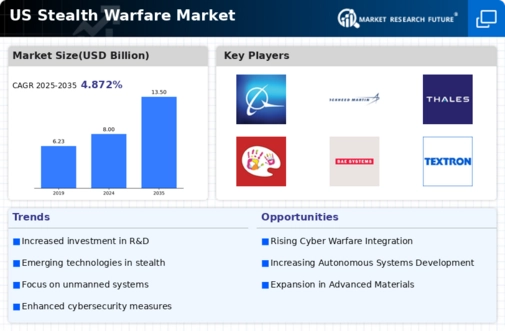Increased Focus on Cyber Warfare
The rise of cyber warfare has significant implications for the stealth warfare market. As cyber threats become more prevalent, the need for stealth capabilities that can operate in both physical and digital domains is paramount. The US military is adapting its strategies to incorporate cyber operations alongside traditional stealth tactics. This shift is likely to drive demand for integrated systems that can ensure operational security in both realms. The stealth warfare market may see a surge in investments aimed at developing technologies that protect against cyber threats while maintaining stealth advantages, potentially leading to a market growth rate of XX% over the next decade.
Modernization of Military Assets
The modernization of military assets is a critical driver of the stealth warfare market. The US Department of Defense is actively pursuing initiatives to upgrade existing platforms and develop new stealth technologies. This modernization effort includes the replacement of aging aircraft and naval vessels with advanced stealth systems designed to enhance survivability and effectiveness in combat. The projected budget for military modernization is estimated to exceed $XX billion over the next five years, indicating a robust commitment to enhancing stealth capabilities. As a result, the stealth warfare market is poised for growth as new contracts and programs emerge to support these modernization efforts.
Advancements in Sensor Technology
Advancements in sensor technology play a pivotal role in shaping the stealth warfare market. The integration of sophisticated sensors into stealth platforms enhances their operational effectiveness. These sensors enable real-time data collection and analysis, allowing for improved decision-making in combat scenarios. The US defense sector is investing heavily in these technologies, with estimates suggesting that spending on sensor systems could account for over 30% of total defense budgets in the coming years. As a result, the stealth warfare market is expected to benefit from these innovations, leading to more capable and versatile stealth platforms that can operate effectively in diverse environments.
Strategic Partnerships and Collaborations
Strategic partnerships and collaborations among defense contractors are increasingly influencing the stealth warfare market. The US defense industry is witnessing a trend towards joint ventures and alliances aimed at pooling resources and expertise to develop advanced stealth technologies. These collaborations can accelerate innovation and reduce costs, making it easier to bring new stealth systems to market. The stealth warfare market may benefit from these partnerships, as they often lead to the creation of cutting-edge solutions that meet the evolving needs of the military. As defense budgets continue to grow, the emphasis on collaboration is likely to enhance the competitive landscape of the stealth warfare market.
Emerging Threats and Geopolitical Tensions
The stealth warfare market is increasingly driven by emerging threats and geopolitical tensions. As nations face evolving security challenges, the demand for advanced stealth technologies rises. The US military, in particular, is prioritizing investments in stealth capabilities to counteract potential adversaries. This focus is evident in the projected growth of the market, which is expected to reach approximately $XX billion by 2030. The need for enhanced situational awareness and the ability to operate undetected in contested environments are critical factors influencing the development of stealth systems. Consequently, the stealth warfare market is likely to expand as defense budgets allocate more resources to address these pressing concerns.






















Leave a Comment